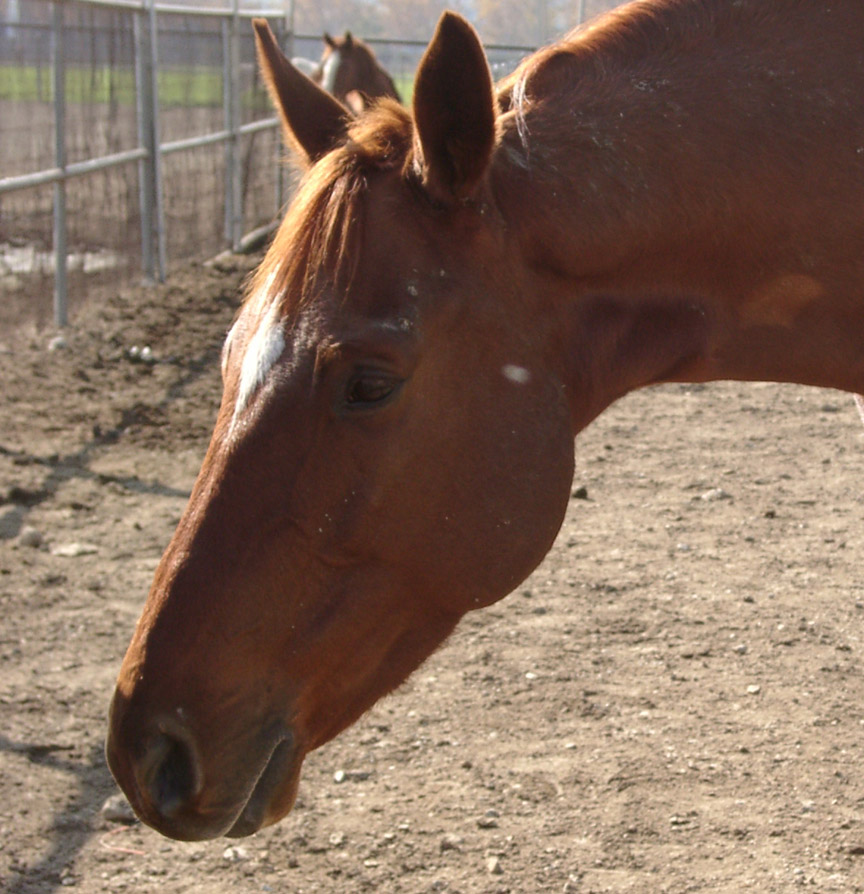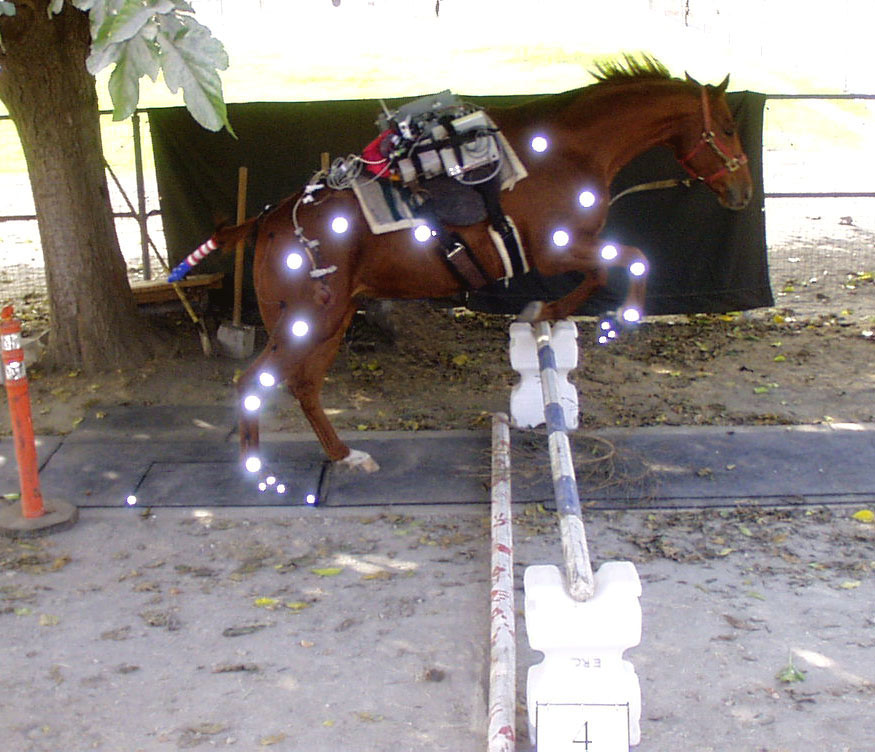How “the Force” Rescued a Horse Named Anakin
by Michaela Eaves

Around the time Star Wars: The Force Awakens prepared to hit theatres everywhere, a drama of a different sort was taking place for a horse named Anakin.
It all started with an ad on Craigslist for a free horse. A woman stopped by to check the horse out and noticed two horses in the pasture suffered from serious neglect. She asked to take them both and upon agreement from the owners, took them to the house where she boarded her own horses. The owner of that house was Karin Earnst.
Both horses were in bad shape but one, Silver, had managed to stay in better shape by stealing food from the other. A couple of days later the thinner of the two, an older Thoroughbred named Anakin, was down and couldn’t stand back up. Earnst called the Washington State Animal Response Team (WASART). Through WASART’s Facebook page she knew the team had recently purchased a tripod and had been using it to raise cast horses.

Though WASART would normally have to travel from Enumclaw, about two hours to the north, a small response team happened to be in nearby Randle and headed out to Winlock to see what help they could give. On scene, they set up the metal Häst tripod and outfitted Anakin with the Becker sling, developed especially for horses. Winlock’s small-town sense of community meant neighbors turned out and were on hand to help raise Anakin by lending muscle to the haul lines.The team left Anakin standing on his own and Earnst called the vet.
With a body condition score of one, Earnst realized Anakin required more than she and her boarder could provide in feed and vet care. Bringing a horse back from that kind of starvation can be difficult as the organs begin to shut down. Starvation victims—animal or human—can experience “re-feeding syndrome.” This can include kidney, heart or respiratory failure, arrhythmia, and other complications. Earnst called local horse rescues, but these are almost always full, especially during the cold and rainy winter months. Finally she found one willing to take Anakin—Save a Forgotten Equine (SAFE) in Woodinville, Washington. While Earnst was working on finding Anakin a place at SAFE, he lay down again and WASART was called in a second time.

This time, the team rolled Anakin first. Sometimes a horse just needs a little help. Rolling a horse to its other side can give it momentum or allow it to try to get up on a side that may be stronger. This did not occur with Anakin so the team set up the tripod and Becker sling again. WASART responders stay emotionally guarded when raising horses. If a horse is cast, it’s often an indication of a serious medical issue. Often, the raise confirms euthanization is the best course of action for the horse as it simply gives up from exhaustion or pain. During both responses to help raise Anakin, the teams noted his calm demeanor, as well as his interest in fighting to live. He did not seem concerned about the noise and movement going on around him. He worked hard when it was time to get up and remained alert and curious throughout.
Once Anakin was on his feet again, the owner and caretaker walked him a bit, while a trailer was prepared for a very short trip down the road so Anakin could spend the night in a warm and dry arena while details with SAFE were worked out. The next day, Anakin was cleared by a vet to make the trip north to SAFE. Veterinarian Dr. Hannah Mueller of Cedarbrook Veterinary Care in Snohomish took over Anakin’s medical care. Once in a stall with his blankets removed, Bonnie Hammond, Executive Director at SAFE wrote this in a blog post: “In ten years of rescue, I have never seen a horse as thin as Anakin is right now. His body could be used to teach an equine anatomy lesson.”
Dr. Mueller did some blood tests to check the horse’s liver and kidney functions and both showed no indication of permanent damage. That evening, SAFE board member Jet Parrett did some research on Anakin’s tattoo, uncovering a remarkable background.

Twenty-year-old Anakin (registered name: Intercopilot) had a short and unsuccessful career as a racehorse and wound up in a kill pen at the age of three. He was rescued from that sad fate by researchers from Cal Poly Pomona. He spent the next twelve years as a research horse, helping students study locomotion, exercise physiology, biomechanics, energetics and high altitude effects. Holly Greene, a researcher at Cal Poly worked extensively with Anakin. Greene described Anakin in a SAFE blog post as a phenomenal horse for this work, and said that he was very well loved by the students that came through the research center. He was so good natured that even the most inexperienced students could work with him safely. The horses in the research string were treated with great care, receiving a lot of grooming, handling and treats. Anakin was one of the few Thoroughbreds in the study and his personality made him a favorite with both staff and students.
The research department lost funding when the director of the program at Cal Poly passed away in 2007. Anakin was given to a student who gave him a good home as a dressage horse for a time. There is a gap in Anakin’s story as to how he ended up in Washington State, emaciated and fighting for his life. His fascinating past, however, explains the gelding’s unusual comfort being handled with WASART’s strange equipment.
Anakin spent a couple of weeks in Dr. Mueller’s care then graduated to free feeding. After casting himself again, the decision was made to transfer him to Pilchuck Veterinary Hospital, a nearby facility which could monitor the horse 24 hours a day. Pilchuck fitted Anakin with a harness to wear and put him in a stall with a hoist so he could easily be lifted again. This proved to be a fortunate decision as the horse took a number of naps and required assistance standing for over three weeks during recovery.
Anakin was able to return to SAFE’s facility about six weeks after his rescue story began. He continues to improve and serve as a teacher: Shortly before Anakin’s release from Pilchuck, Hammond received a letter from a local 4-H group who had visited Anakin. His emaciated state allowed the group to see anatomical features they normally wouldn’t be able to see on a healthy horse.
Like the movie franchise that inspired Anakin’s name, this horse has experienced a lot of drama. Hopefully, he is now at the beginning of a much deserved happy ending.
Michaela Eaves is on WASART’s board of directors and can be contacted at [email protected]. Learn more about this organization at washingtonsart.org or on their Facebook page.
I’m a UX and visual designer working in the Seattle and Bellevue areas. I have experience working on various platforms – desktop online services, mobile apps, and experimental hardware. I have a BFA in Graphic Design, and I do a bit of illustration when a fun project comes up. In my free time, I hang out with my dog, mountain bike, and volunteer to rescue animals though rarely all at the same time.




